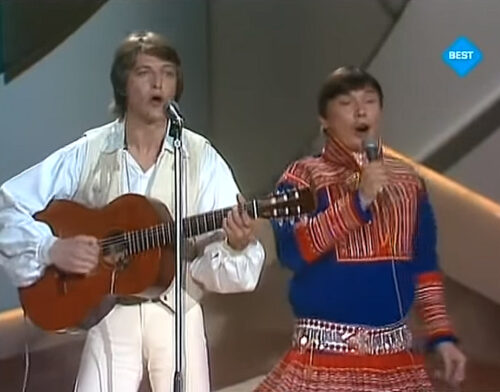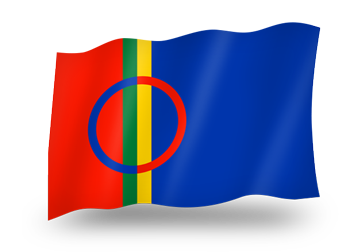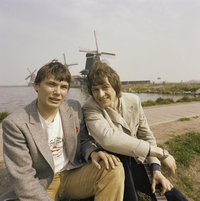photo: Nationaal Archief, Den Haag
We know a lot about Eurovision and we want to share this knowledge with you! Therefore we’d like to bring you a blast from the past. Today: Mattis Hætta and Sverre Kjelsberg, representing Norway in 1980 with the song “Samiid Ædnan”.
Norway in the Eurovision Song Contest
Norway has had a long and varied history in the Eurovision Song Contest, which they first entered in 1960. Over the years, Norway has experienced both highs and lows in the competition.
Norway has won the contest three times:
- 1985 – Bobbysocks: The duo, consisting of Hanne Krogh and Elisabeth Andreassen, won with the song “La det swinge” (Let it swing). This victory was a landmark moment for Norway, as it was their first win in the contest.
- 1995 – Secret Garden: An instrumental piece, “Nocturne”, with just 24 words sung by Norwegian violinist Rolf Løvland and Irish violinist Fionnuala Sherry, secured Norway’s second victory.
- 2009 – Alexander Rybak: The singer, violinist, composer, and actor won with a record-breaking 387 points for his song “Fairytale”. This score remained the highest in Eurovision history until the voting system was changed in 2016.
Despite their victories, Norway is also known for having finished last a number of times, often with the infamous ‘nul points’. Some of these instances have become iconic in Eurovision history, showcasing the unpredictable nature of the contest.
Melodi Grand Prix 1980
The national final, Melodi Grand Prix, was held on March 22nd at NRK Studio 2 in Oslo. Åse Kleveland, participant in 1966 and hosting Eurovision in 1986, was the host of the show. Note that she also traveled along with Mattis Hætta and Sverre Kjelsberg to The Hague to introduce the duo. Every country had their own host in the 1980 show.
The songs were:
- “Stjerneskudd“, by Anita Skorgan, 48 pts, 6th
- “Ja“, by Jahn Teigen, 32 pts, 9th
- “Parken“, by Radka Toneff, 43 pts, 8th
- “Bjørnen sover“, by Åge Aleksandersen og Sambandet, 61 pts, 1st
- “Maestro“, by Hilde Heltberg, 32 pts, 9th
- “Auståvind“, by Hennig Sommerro, 45 pts, 7th
- “Univers“, by Alex, 58 pts, 3rd
- “Rudi“, by Nina Askeland, 58 pts, 3rd
- “Svart fortid“, by Inger Lise Rypdal, 57 pts, 5th
- “Samiid ædnan“, by Mattis Hætta and Sverre Kjelsberg, 61 pts, 1st
As there was an ex aecquo between both the songs, all the juries had to give one vote for one of the winning songs. In that voting, “Bjørnen sover” received 4 points while “Samiid ædnan” got 5.
Age Aleksandersen, the other winner
Mattis Hætta and Sverre Kjelsberg
Sverre Kjelsberg was a multifaceted Norwegian musician, born on October 18, 1946, in Tromsø, and passing away on June 18, 2016. He began his musical journey as a bassist and vocalist for the popular 1960s rock band, The Pussycats. Known for their Beatlesque style, the band enjoyed considerable success domestically. After the band’s dissolution, Kjelsberg’s musical style evolved, incorporating elements of pop, rock, and folk.
Sverre Kjelsberg is perhaps best remembered on the international stage for representing Norway in the Eurovision Song Contest in 1980, alongside Mattis Hætta, with the song “Sámiid Ædnan.”

Mattis Hætta was a Sami singer and artist renowned for his contribution to the preservation and popularization of the traditional Sami form of singing, known as joik. Born on March 24, 1959, in Maze, Norway, Hætta was a prominent figure in the indigenous Sami community. His musical journey was intertwined with his cultural identity, and he has used his artistry to advocate for the rights and recognition of the Sami people. Mattis Hætta has continued to advocate for indigenous rights and remains a celebrated figure in Norway for his cultural contributions and activism. He passed away on November 9, 2022.
Who are the Sami?
The Sami are an indigenous people inhabiting the Arctic region known as Sápmi, which spans across the northern parts of Norway, Sweden, Finland, and the Kola Peninsula of Russia. Numbering approximately 80,000 to 100,000, the Sami have a rich cultural heritage deeply intertwined with the natural landscapes they inhabit.
Traditionally, the Sami have engaged in diverse livelihoods, including fishing, fur trapping, and sheep herding. However, reindeer herding is perhaps the most emblematic aspect of Sami culture, with specific communities having developed semi-nomadic lifestyles centered around reindeer migrations.
The Sami have their own distinct languages, which belong to the Uralic linguistic family. While there are multiple Sami languages, many Sami people also speak the languages of the countries they reside in.

Sami traditional clothing, known as “gákti,” is vibrant and distinctive, often adorned with colorful bands of decoration and intricate beadwork. The designs and colors can indicate a person’s geographical origin, marital status, and other personal details.
Despite facing historical oppression and forced assimilation policies, the Sami have persevered in maintaining and revitalizing their cultural heritage. Today, they continue to advocate for their rights, including land rights, cultural preservation, and political representation within the Nordic countries and Russia.
Apart from Mattis Hætta and Sverre Kjelsberg, also Keiino brought the audience something of the Sami culture. Sami rapper Fred Buljo brought us the sound of the joik too!
Samiid Ædnan
“Sámiid Ædnan” is a significant and memorable song that represented Norway in the Eurovision Song Contest in 1980. Sung by Sverre Kjelsberg and Mattis Hætta, the song is a powerful melding of pop music elements with the traditional Sami form of singing known as joik.
The title “Sámiid Ædnan” translates to “Sami Earth” and the song’s lyrics are a call for recognition of the indigenous Sami people and their rights. The song is performed in both Norwegian and Sami languages and emphasizes the unity and connection of the Sami people with their land.
What made the performance standout in the Eurovision contest was Mattis Hætta’s joiking and the duo’s choice to wear traditional Sami clothing. This was an act of cultural pride and a political statement about indigenous rights. The song was written as a protest against the construction of a dam in the area where the Sami live. So, it was a protest song. During the Eurovision week, another Sami had barricaded themselves in a small tent in front of the congress building in The Hague.
Though it finished in 16th place out of 19 entries, “Sámiid Ædnan” left a lasting impact. It transcended the competition by raising awareness about the Sami people’s struggle for recognition and cultural preservation. Over the years, the song has retained its resonance and is celebrated as a milestone in both Norwegian and Sami musical history.


